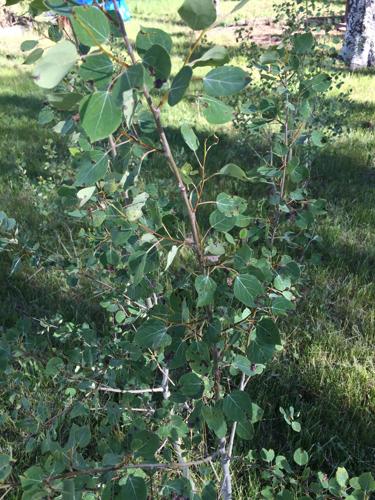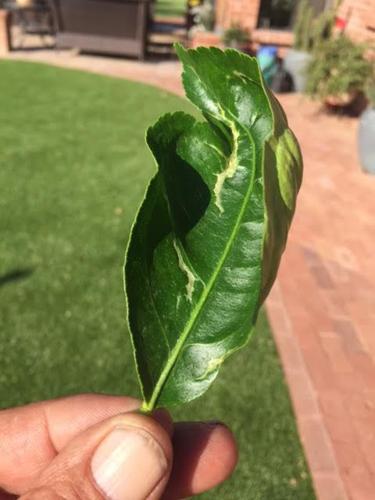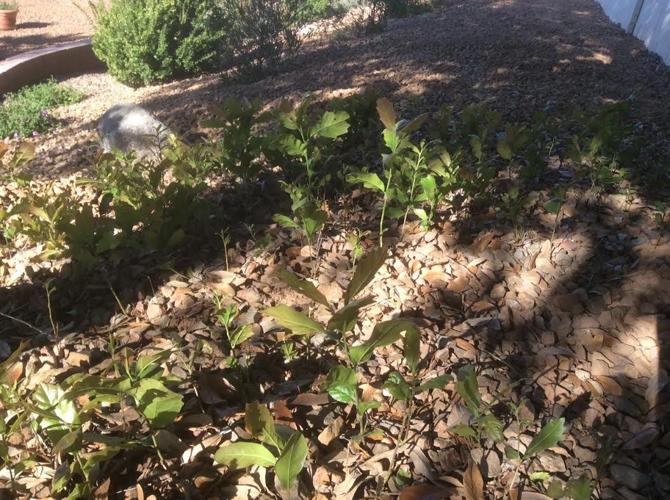Question: My aspen trees have scale insects on the bark and some disease on the leaves that causes them to drop off early. What can I do?
Answer: The insects are called oystershell scale (Lepidosaphes ulmi) and they feed on the bark and branches. Large populations can reduce the vigor of the trees and make them susceptible to other problems. These insects may be scraped off the trees by hand or if heavily infested, pruning branches might be best. Alternatively, you can spray them with horticultural oil in the spring when the immature crawler stage is active. That should be right about now but you should examine the bark with a magnifier to see if they are out from under their parent’s protective cover and moving about. From your photo, I think your trees are also suffering from Marssonina leaf spot disease. The black spots with yellow halos in the photo you sent fit the description and this is a common leaf disease of aspen trees. The important thing about the common leaf diseases in aspen trees is that they are all managed in a similar fashion. The most important tactic is sanitation because the diseased leaves on the ground are a source of inoculum. If you have a few of these trees, this might not be a big challenge. I’m not sure how practical removing and destroying the diseased leaves is in a large stand of these trees. If you choose to use a fungicide, there are quite a few to choose from that could help. Look for those that are labeled for use on trees and shrubs. Some common active ingredients include propiconazole, chlorothalonil, mancozeb, and captan.
Question: Can you tell me what this is on my grapefruit tree and how to get rid of it?
Answer: Unfortunately, your grapefruit tree has a disease commonly called gummosis (Phytophthora species). This disease is common in the soil and may be introduced through wounds or cracks in the bark. A contributing factor is irrigation. Flood irrigation or systems that consistently spray water on the trunk of the tree can not only weaken the bark but also provide a liquid pathway for the fungi to move from the soil into the tree. One of the signs we see is the oozing from cracks in the bark as the disease moves through the tree. Sometimes we also see bark sloughing off as branches succumb to the disease. Some trees will live a few years with this disease and you can help by spraying fungicide on actively oozing areas. In other cases, the tree may die within a year. Once the disease spreads to the trunk and/or most the tree, it is time to plan for its removal.
Question: I’m experiencing leaf curling on my mature lemon tree, most notably on the new leaf growth. Most of the new growth is also much larger in leaf size than on the established limbs. This tree flowered wonderfully last month and there is a nice crop of fruit growing. I haven’t found any signs of insects on the leaves but there is a definite veining occurring which I tried to capture on the attached photos. I’ve been deep watering this tree every three to four weeks trying to keep moisture at the 36-inch depth and am fertilizing every three months (first dose at the beginning of February each year). Can you please help me with some of your sharp analysis and provide recommendations for treating?
Answer: Your citrus leaves are being eaten by tiny insects called citrus thrips (Scirtothrips citri). The females lay their eggs in new leaf tissue and when the young thrips feed, they cause curling, distortion and scaring. They may also lay eggs in and scar the rind of the fruit. The good news is they don’t do enough damage to warrant any concern unless you own an orchard and want to sell the fruit to a grocery store. The leaves are still photosynthesizing despite their contorted appearance and the fruit are as numerous and tasty as the ones you buy at the grocery store without any scars.
Question: I have a desert oak tree on the landscaped embankment in my back yard in Oro Valley. The tree is nearly 20 years old and for several years now it has produced a progressively larger amount of suckers (or maybe they are upward protruding roots that grow leaves). They cover a large area under the tree and are starting to lift up the adjacent flagstone stairs and are spreading into other landscaping. I try pulling them up only for them to continue to grow back. I have tried using the product “Sucker Stopper” that I purchase at a local nursery. It seems to only temporarily retard the growth and that product is quite expensive ($50) for a small spray bottle). I have also tried using a flame torch but that also is only a temporary solution. I have attached some pictures of the sucker growth. Do you have any advice on how I can stop the growth of these suckers?
Answer: This is an unfortunate feature of some live oaks (Quercus species). There is no way to stop the sucker growth completely since they are part of the tree and they will continue to grow back. You could mow them down to a manageable size periodically but you probably don’t want to spray them with something that might harm the tree. Or do you? The glass half full perspective is they make a nice ground cover but you might not want a tiny forest under your tree so cutting and digging them out is what’s left.







